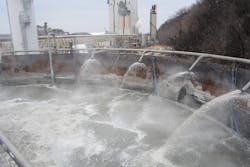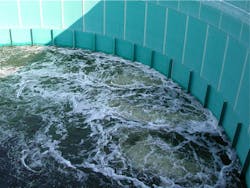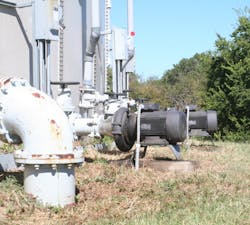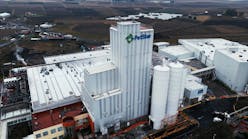If engineers want to prove to their customers they are providing the best possible long-term solutions, then they need to look further than mere conventional aeration, according to Soren Rasmussen, director of Landia Inc.
"In fact, they may only have to pick up the bad odors emanating from an industrial plant to know that something somewhere isn’t right," Rasmussen said. "A rotten egg smell of hydrogen sulfide that may be wafting its way up from a storage lagoon will almost certainly have developed — and quite quickly — from an anaerobic environment caused by dead particles falling to the floor because the oxygen transfer is not great enough for the type of sludge."
An aerator with chopper pump and ejector system provides simultaneous aerating and mixing. | All images courtesy of Landia Inc.
A study of aeration
At Camstar Herbs, Landia solved just such a problem where, during the long harvest season from May to November, unpleasant odors were emanating from the lagoons at the 500-acre site, caused by fermenting wastewater from herbs such as chamomile, parsley, coriander and chervil. Now, two 7.5-kilowatt (kW) aerators consisting of a chopper pump and an ejector system aerate the sludge in the main 500,000-gallon lagoon and mix the wastewater. A separate inlet lagoon also benefits from a 5.5 kW aerator that points directly at the inlet pipe. Set up to work at night or whenever liquor strengths require it during Camstar’s 24-hour operation, the aerators have to be rugged and reliable for an installation in which up to 35,000 gallons of water can be processed per day.
"We’ve recently completed a similar installation for a guar gum producer in Texas," said Rasmussen, "where sludge was settling out on the bottom of their effluent lagoon. The consultant had advised the owner that floating aerators were best and had adhered to the tried and tested textbook calculations — but the floating aerators could not reach the depths where the sludge was accumulating. The [submersible aerators], which recirculate sludge and inject air at the bottom of the lagoon, were able to resuspend the solids and provide the necessary aeration and mixing.
"A food processor, dairy or chemical company might look at all the surface bubbles and initially be content with all the apparent aeration activity, but achieving optimal conditions for a tank or lagoon is not just about surface aeration, it is about in-depth mixing and aeration, too. We believe it is best to judge each installation on an individual basis. Does it need aerating, mixing — or a combination of both — but then that advice doesn’t seem to appear in the textbook. An optimal solution for anyone dealing with a difficult wastewater application — with high or low solids — is better given by manufacturers who can provide a harmonious system that not only aerates and mixes, but also reduces the particle sizes without getting clogged up."
All too often, claims Rasmussen, a system that has been used in a municipal plant with less than 0.5 percent solids, is somehow judged to be able to manage a tank with industrial effluent with anything from 2 to 5 percent solids. It is not just the solids content though that seems to be overlooked. Effluent laced with chemicals, sugars and starches will always present challenges.
He says that, for example, a brewery with relatively low solids in its wastewater will have to deal with high biochemical oxygen demand (BOD) from all the sugar and alcohol that need to be reduced before discharge to the sewer network. If large blowers are employed to aerate wastewater with high BOD, one outcome is always certain: eye-watering energy costs. This, stresses Rasmussen, is just one area where it is time to move into the 21st century.
"Going back as we do at Landia to 1933, we’re all proponents of engineered, tried and tested solutions," he said. "But environmental concerns are very different these days — not to mention profit-zapping energy bills. More nutrients in wastewater mean more aeration, meaning more expense. Brewery effluent, like many industrial wastewaters, can also be quite corrosive with high or low pH wastewater as well as hydrogen sulfide, which will eat away at equipment unless, as we insist upon, it is made from stainless steel. For Hook Norton Brewery, our chopper pump, which forms part of [our aerator], aerates wastewater at a loading rate of 10 kilograms chemical oxygen demand per cubic meter. The knife system on our chopper pumps ensures that solids cannot get into the pump and clog it up, so there is no downtime. The specially designed pump casing and impeller also protect it from
impurities."
Externally mounted chopper pump aeration system at Gun Barrel City
Aerator design and maintenance
Even if an aeration system is working efficiently, its type and design may prove too much of a costly maintenance headache, involving far too much downtime. This and energy bills were the case at a major manufacturer of starch products, syrups and polyols (sugar alcohols). Located in Keokuk on the Iowa/Illinois border, the heart of corn production country, Roquette America previously utilized floor-mounted air diffusers powered by large blowers and several surface mixers to try to aerate and mix its primary and secondary oxidation tanks.
However, this standard industry practice meant constant cleaning and replacing of diffuser membranes. Since Roquette operates 24/7, the process could not be suspended to drain the tanks. This resulted in the substantial outlay of having to hire divers to enter the tanks and carry out maintenance.
Rob Decker, senior project coordinator at Roquette, was searching for new technology to reduce maintenance time and costs associated with his aeration tanks. A design for the installation of nine aerator systems and the addition of one mixer per tank reduced maintenance to a simple, economic annual requirement, while as a bonus, energy costs have been lowered by 30 percent.
"If the situation demands it," continued Rasmussen, "we will sometimes supplement the operation with propeller mixers, which again, are low-energy and low-maintenance. Taking an aeration basin offline, or having to send in divers as they used to have to do at Roquette, is very costly and labor-intensive."
Paper mill maintenance
Maintenance was not at the top of the agenda at the Skjern Papirfabrik paper mill. Odors had become so bad that local residents and the media had mounted a campaign for the plant’s closure.
This equipment provides simultaneous aerating and mixing.
Lene Lange Andersen, head of laboratory operations at Skjern Papirfabrik, said, "The situation was completely precarious, but within just a few days Landia produced and supplied two pumps with jet aeration equipment. The design allowed installation to be carried out in full tanks so we were able to start right away. The following day, the stench had been reduced considerably. We have since gone on to have [five pumps] in the sludge holding tank, which [have] completely eliminated the odors."
Not only did the aeration system eliminate the unpleasant smell by the efficient aeration of the tank contents, it also brought about additional benefits, which were noted by the head of the environment and energy department at the paper mill, Soren Baek.
"The wastewater for our treatment plant has become significantly cleaner and we do not have to use as much energy as we used to when preparing it for final treatment at the town’s treatment plant," Baek said. "By pointing one of the aerators directly into the part of the tank where the contents normally settle, we could remove the sludge in the tank. Previously we had to remove 12 cubic meters of sludge from the bottom of the tank."
Better cleanliness, an improved wastewater process and reduced maintenance costs have all begun to stack up as reasons to introduce mechanical mixers for optimum aeration, but as Rasmussen concludes, the willingness to reduce power still seems to have some way to go.
"A treatment plant we were working with just recently gave us figures they’d been advised to use for over 1,500 hp of mixing energy — specified by a consultant who’d gone no further than the old textbook approach. We questioned it and we were able to show that we could help provide better, more comprehensive mixing for just one-fifth of the power.
Installing aeration equipment requires serious thought for any plant wanting to drive towards becoming energy neutral."
Chris French is a freelance journalist who specializes in wastewater/biogas. Landia Inc. is a subsidiary of Landia A/S, established in 1933. For more information, visit landia.co.uk.





